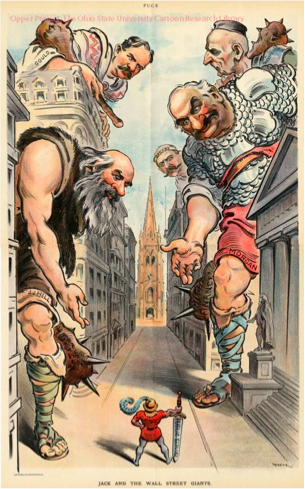World City: Curating for an Historical Exhibition
Social Studies

Essential Question
How do you “read” an image to learn its message, context, and usefulness in telling a story?
Objectives
- Students will learn to analyze a political cartoon and determine its curatorial value.
- Students will understand how a powerful image can communicate information and opinions while appealing to an audience’s emotions in a different, and sometimes more profound, way than written text.
- Students will think like museum curators when carefully selecting images that will help them communicate their point.
- Students will utilize a combination of student written text and visual images culled from their research to argue and support a thesis statement about the topic they have researched.
- Students will learn about Theodore Roosevelt, Tammany Hall, Wall Street, and the Progressive Era.
Standards
CCSS.ELA-Literacy.RH.6-8.1
Cite specific textual evidence to support analysis of primary and secondary sources.
CCSS.ELA-Literacy.RH.6-8.7
Integrate visual information (e.g., in charts, graphs, photographs, videos, or maps) with other information in print and digital texts.
Distinguish among fact, opinion, and reasoned judgment in a text.
- Look and Discuss
- Background
- Practice Worksheet
- Share
- Independent Work
- Continuation
Procedures
Display or distribute copies of the political cartoon “Jack and the Wall Street Giants.” This image about the Progressive Era shows Theodore Roosevelt standing up to the titans of big industry of the time. It contains the faces of the “Wall Street Giants.” The image represents a particular perspective – one that could strongly support a thesis statement that favors Roosevelt in history. Ask students to respond to the following questions first in writing and then as part of a whole group discussion:
What historical figures does the cartoonist depict in this cartoon? How do you know?
Who are the “good guys” in this cartoon? Who are the “bad guys?” What do you see that tells you a character is being portrayed positively or negatively?
Why do you think the cartoon is called “Jack and the Wall Street Giants”?
One of the greatest challenges that students face is succinctly stating a thesis for a research project, particularly when creating media-based projects. After conducting such thorough and rich research, students must figure out how to convey the information in a concise and powerful way.
Museum curators face similar challenges. Museum curators have to engage visitors through the interplay of design, artifacts, and a limited amount of text. Most museum-goers will not spend very long looking at a particular part of an exhibition.
This lesson includes a “Picture Is Worth a Thousand Words Curatorial Litmus Test.” One image can convey a great deal about a particular place and time, including the attitudes or opinions held by people living at the place and time depicted in the image. Have students carefully select images that will do some of the work for them in terms of stating information and supporting a thesis. This tool is meant to help students decide whether a particular artifact, video, or image is worthy of being included in their project.
Using this tool, have students study the political cartoon at the top of the lesson. Ask them to imagine working on a project about Theodore Roosevelt’s role in bringing about reforms in the country during the Progressive Era. (If students need more background information about the Progressive Era, have them read the brief summary of the Progressive Era from the George Washington University, Eleanor Roosevelt papers website: https://www.gwu.edu/~erpapers/teachinger/glossary/progressive-era.cfm).
Ask students to imagine that their thesis statement is the following: By enacting a series of laws to protect workers and consumers, Theodore Roosevelt redefined the role of the federal government to that of a watchdog protecting its citizens against the abuses of industry and big business.
Use the “Picture Is Worth a Thousand Words Curatorial Litmus Test” to determine whether or not this political cartoon would be a good choice to use in a project.
Have students share their responses with the class.
Ask the students to use this tool to illustrate how and why they have selected at least three different images.
Have students apply this litmus test (by filling out the worksheet) to an image they’ve selected for a thesis topic of their own.
Acknowledgements
New York at Its Core lesson plans were developed in conjunction with a focus group of K-12 New York City teachers from public, private, and parochial schools: Maryann Cooke, Maria Diaz, Sasha Domnitz, William Fong, Gina Giannone, Peter Lapre, Edina Lawson, James Randle, Judy Sokolow, and Matt Thoren. We thank the New York City Department of Education’s Office of Social Studies for supporting the public school teachers’ participation.

